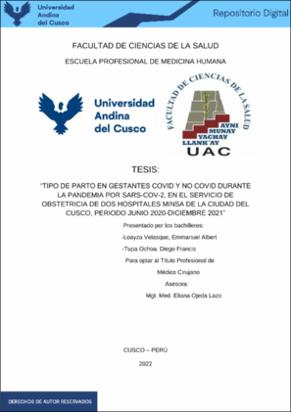| dc.contributor.advisor | Ojeda Lazo, Eliana Janette | |
| dc.contributor.author | Loayza Velasque, Emmanuel Albert | |
| dc.contributor.author | Tupa Ochoa, Diego Francis | |
| dc.date.accessioned | 2022-08-31T19:34:24Z | |
| dc.date.available | 2022-08-31T19:34:24Z | |
| dc.date.issued | 2022-08-25 | |
| dc.identifier.uri | https://hdl.handle.net/20.500.12557/4824 | |
| dc.description.abstract | Objetivo: Comparar el tipo de parto en gestantes COVID-19 y no COVID-19 durante la
pandemia por SARS-CoV-2.
Métodos: Estudio de casos y controles, de tipo observacional, descriptivo, retrospectivo y
correlacional. Del total de 8420 gestantes que dieron a luz en ambos hospitales durante el
periodo de tiempo, se halló un tamaño de muestra de 389 partos, usándose la misma cantidad
para casos y controles. Se realizó análisis univariado y bivariado.
Resultados: Evaluadas las 390 gestantes con COVID-19 y 390 gestantes sin COVID-19 que
dieron a luz, se obtiene que la edad promedio en ambos grupos fue de 27.3 ± 6.5 años, al
comparar edad por separado no hubieron diferencias significativas. La prevalencia de COVID19
en
gestantes
que
dieron
a
luz
en
ambos
hospitales
fue
de
7.2%.
En
cuanto
a
la
clasificación
de
Robson
en
el
grupo
no
COVID-19
predominaron
el
5,
1
y
3
con
27
(21.6%),
26
(20.8%)
y
25
(20.0%)
respectivamente;
mientras
que
en
el
grupo con
COVID-19
prevalecieron
el
5,
1
y
10
con
45
(25.4%),
42
(23.7%)
y
27
(15.3%)
respectivamente.
Se
evidenció
mayor
incidencia
de
parto
pretérmino
en
el
grupo
que
tuvo
cesárea
con
SARS-CoV-2
activo
al
momento
del
parto,
13 (10.4%), versus 34 (19.2%) en cesareadas sin infección; esta correlación fue
significativa con un OR 2.05 e IC 95% (1.03 – 4.06). La tasa de cesáreas fue de 45.4% en los
casos y 32.1% en controles (OR 1.76; IC 95% [1.316 – 2.357]).
Conclusiones: No hay diferencia entre los promedios de edad en casos y controles. Existe
significancia entre el tipo de parto y la enfermedad o no por COVID-19, hallándose mayor
tasa de cesáreas en gestantes con COVID-19. Asimismo hubo mayor cantidad de partos
pretérmino por cesárea en gestantes con SARS-CoV-2. | es_PE |
| dc.description.abstract | Objective: To compare the type of delivery in COVID-19 and non-COVID-19 pregnant women
during the SARS-CoV-2 pandemic.
Methods: Case-control study, observational, descriptive, retrospective and correlational. Of
the total of 8420 pregnant women who gave birth in both hospitals during the period of time,
a sample size of 389 deliveries was found, using the same amount for cases and controls.
Univariate and bivariate analyzes were performed.
Results: Once the 390 pregnant women with COVID-19 and 390 pregnant women without
COVID-19 who gave birth have been evaluated, it was found that the average age in both
groups was 27.3 ± 6.5 years, when comparing age separately there were no significant
differences. The prevalence of COVID-19 in pregnant women who gave birth in both hospitals
was 7.2%. As for Robson’s classification in the non-COVID-19 group, 5, 1 and 3 predominated
with 27 (21.6%), 26 (20.8%) and 25 (20.0%) respectively; while in the group with COVID-19,
5, 1 and 10 prevailed with 45 (25.4%), 42 (23.7%) and 27 (15.3%) respectively. There was a
higher incidence of preterm delivery in the group that had cesarean section with active SARSCoV-2
at the time of delivery, 13 (10.4%) versus 34 (19.2%) in cesarean sections without
infection; this correlation was significant with an OR 2.05 and CI 95% (1.03 – 4.06). Vaginal
delivery was the most prevalent type of delivery in both groups, but the cesarean section rate
was 45.4% in cases and 32.1% in controls (OR 1.76; 95% CI [1.316 – 2.357]).
Conclusions: There is no difference between the mean ages in cases and controls. There is
significance between the type of delivery and the disease or not by COVID-19, finding a higher
rate of cesarean sections in pregnant women with COVID-19. There was also a greater
number of preterm deliveries by cesarean section in pregnant women with SARS-CoV-2. | en_US |
| dc.format | application/pdf | es_PE |
| dc.language.iso | spa | es_PE |
| dc.publisher | Universidad Andina del Cusco | es_PE |
| dc.rights | info:eu-repo/semantics/openAccess | es_PE |
| dc.rights.uri | https://creativecommons.org/licenses/by-nc-nd/4.0/ | es_PE |
| dc.subject | Parto | es_PE |
| dc.subject | Cesárea | es_PE |
| dc.subject | SARS-CoV-2 | es_PE |
| dc.title | Tipo de parto en gestantes Covid y no Covid durante la pandemia por Sars-Cov-2, en el servicio de obstetricia de dos hospitales Minsa de la ciudad del Cusco, periodo junio 2020-diciembre 2021 | es_PE |
| dc.type | info:eu-repo/semantics/bachelorThesis | es_PE |
| thesis.degree.name | Médico Cirujano | es_PE |
| thesis.degree.grantor | Universidad Andina del Cusco. Facultad de Ciencias de la Salud | es_PE |
| thesis.degree.discipline | Medicina Humana | es_PE |
| dc.publisher.country | PE | es_PE |
| dc.subject.ocde | https://purl.org/pe-repo/ocde/ford#3.03.00 | es_PE |
| renati.advisor.dni | 23953577 | |
| renati.advisor.orcid | https://orcid.org/0000-0001-6606-3029 | es_PE |
| renati.author.dni | 72420714 | |
| renati.author.dni | 71918482 | |
| renati.discipline | 912016 | es_PE |
| renati.juror | Concha Contreras, Hermógenes | |
| renati.juror | Herencia Zapana, Leny Leonor | |
| renati.juror | Rivas Ricalde, Mendel Eder | |
| renati.juror | Bustamante Ramirez, Rory | |
| renati.level | https://purl.org/pe-repo/renati/level#tituloProfesional | es_PE |
| renati.type | https://purl.org/pe-repo/renati/type#tesis | es_PE |


